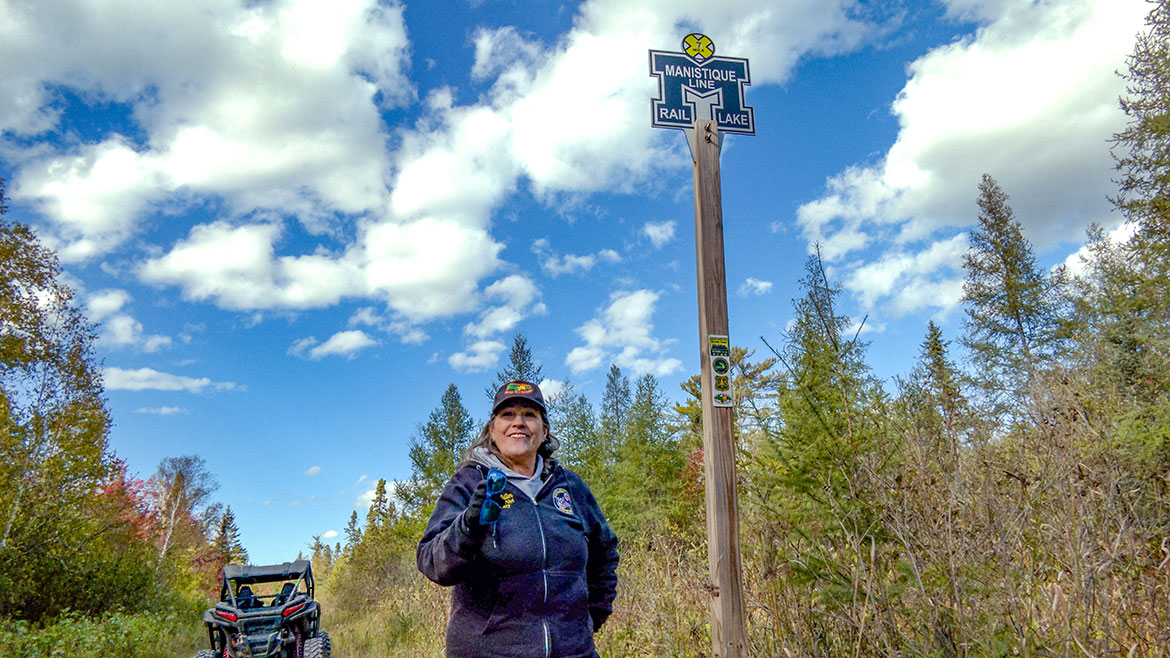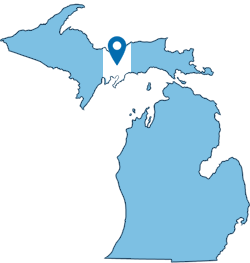Travel Planner
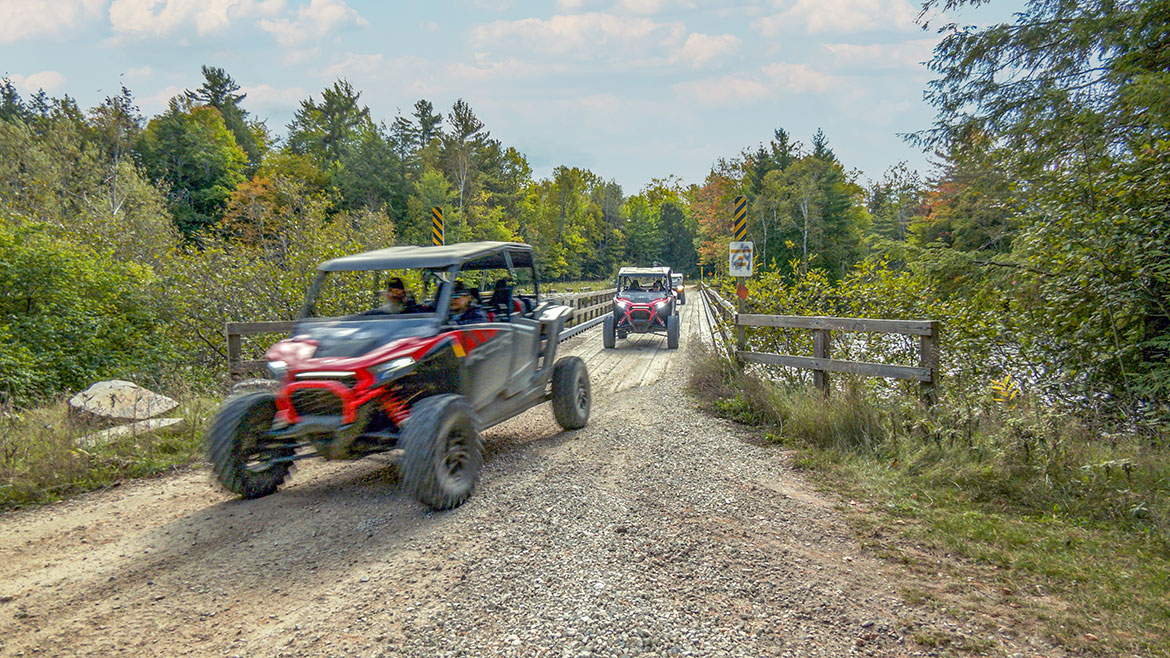
“ATV Fun” Part I
Episode #2205 Travel planner
Riding an ATV in Michigan’s Upper Peninsula is an exhilarating adventure, with miles of rugged trails weaving through dense forests, over rolling dunes, and past breathtaking rivers. We travel a hundred miles on ATVs in the back woods.
Haywire Grade Trail

INTAKE PARK TRAILHEAD
Location: Intake Park Road - Manistique, Michigan (across from Manistique Pumping Station)
Trail: 32 miles between Manistique and Shingleton
The multiuse Haywire Grade Trail stretches 32 miles and crosses the Upper Peninsula, south to north, from Intake Park in Manistique to Shingleton in Schoolcraft and Alger counties. The trail was Michigan’s first rail trail. The trail runs along the old Manistique and Lake Superior Railroad and has since been reclassified as a year-round, multiuse trail – the first in Michigan's Upper Peninsula.
The trail surface is a mix of sand, gravel and coarse limestone, designed for snowmobiles and ATVs, but suitable for fat-tire biking. Mile markers help you track your progress through this secluded second growth forest. You’ll find a small grocery store in the tiny hamlet of Steuben, the last vestige of the many logging camps or towns that vanished after the railroad was abandoned. Converted into a recreation trail in 1970, the Haywire Grade Trail celebrated its 50th anniversary in 2020 with special events and commemorate rides for snowmobiles, equestrians, bicycles and ORVs.
The trail has been recognized as a Pure Michigan Designated Trail and designated as a heritage trail. The heritage trail project includes a series of 11 historical interpretive kiosks that explore the natural and cultural history of the area
- Haywire Grade Trail [Michigan DNR]
- Haywire Grade Trail [Visit Manistique]
ATVs in Schoolcraft County
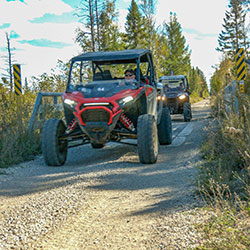
Location: Schoolcraft County, Michigan
Challenging trails for the off-road enthusiast can be found throughout the Manistique area, including the Haywire Grade Trail. Riding opportunities abound along abandoned railroad grades for a near straight jaunt. Hundreds of miles of scenic and historic trails are ready for today’s rider.
- ORV Riding [Visit Manistique]
Schoolcraft County Motorized Trails Association

Location: 300 New Delta Ave, Manistique, Michigan
Phone: (906) 341-4488
They maintain the trail system in their sector of the Central Upper Peninsula of Michigan. The SCMTA strives to provide a medium for exchange of snowmobile and ORV information and to be the catalyst between government entities, businesses and snowmobilers and ORV enthusiasts.
- SCMTA [Facebook]
Manistique River Station
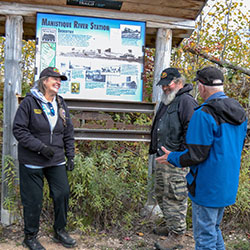
Location: near mile marker 1 - Haywire Grade Trail
INDUSTRY
During the big pine logging era of the late-19th and early-20th centuries, the Manistique River Station was an important stop on the Haywire rail line. Its location along the river made it ideal for transporting logs to the mills and factories that sprang up in the area. By 1924 the logging era was over and the station closed permanently.
The nearby Manistique & Lake Superior track had a triangle section of track called a wye, which made it possible to turn the train in the opposite direction.
1887 - In 1887 Abijah Weston started the Manistique Iron Company, which melted iron ore pellets to produce pig iron. It was later renamed the Charcoal Iron Company of America. It went bankrupt in 1923.
1889 - Access to the area’s dolomite deposits and slab wood fuel led George Nicholson to establish the White Marble Lime Company in 1889.
1907 - The Goodwillie Brothers Box Factory (1907-1920) manufactured custom boxes and crates. The factory was extensively damaged in a flood and never reopened.
1910 - In 1910 the Manistique Handle Company began to produce handles for brooms and feather dusters using woods such as maple, beech and birch. Charles Slining Sr. purchased the factory and renamed it the Northwoods Manufacturing Company in 1929.
1916 - Thomas Berry Chemical Company produced chemicals distilled from wood. During World War I the company produced acetone for the military. Acetone was used in the manufacture of cordite, a smokeless propellant that replaced gun powder.
- Haywire Grade Trail [Visit Manistique]
Sturgeon Hole
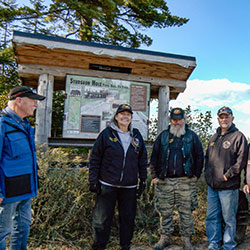
Location: mile marker 5 - Haywire Grade Trail
FROM RAIL TO TRAIL
Sturgeon Hole Station was a sportsman's stop on the Manistique & Lake Superior Railroad. People were drawn to Sturgeon Hole Creek for trout fishing, while a large deer herd attracted hunters.
THE "HAYWIRE"
The origin of the nickname "Haywire" is unknown. Hugh Hornstein, in his book The Haywire, notes three theories stemming from its railroad history.
- 1. "Temporary repairs to railroad equipment were made with wire taken from bales of hay fed to lumber camp horses"
- 2. "Bailing wire was used to secure logs to Russell cars."
- 3. "Section crews responsible for repairing the rails claimed that they were made of hay wrapped with wire."
COMBINED EFFORTS
When the Manistique & Lake Superior Railroad ceased operations in 1968, the conversion of abandoned rail corriders into trails was rare. However, the growing popularity of snowmobiling brought new life to the Haywire. In 1970 a series of land transactions between Schoolcraft and Alger Counties, Hannah Mining Company, the U.S. Forest Service and the Michigan Department of Natural Resources established the Haywire as Michigan's first rail-trail. This pioneering effort was Michigan's first step in becoming the nation's premier trail state, with more miles of rail-trail than any other state by 2020.
TIME LINE
- 1896 - Manistique & Northwestern Railroad opens
- 1909 - Line renamed Manistique & Lake Superior Railroad
- 1968 - Manistique & Lake Superior abandons railroad
- 1970 - Haywire opens as a motorized trail, Michigan's first rail trail
- 2017 - Heritage mile markers installed
- 2020 - 50th Anniversary; Interpretive kiosks installed
- 2020 - Haywire designated as a Pure Michigan Trail
- Haywire Grade Trail [Visit Manistique]
Station Nine

Location: near mile marker 8 - Haywire Grade Trail
HUNTING AND FISHING
In this region people hunt and fish for food, recreation or sport. Though their motives may be different, the wildlife here provides ample game.
Many men go fishing all of their lives without knowing that it is not fish they are after. -Henry David Thoreau
THE OJIBWE
The Ojibwe people believe all animals have a spirit. If you take the life of an animal, you must offer it thanks with the sacred medicine of Asemaa (tobacco) for giving its life to you and your family.
Historically, the Ojibwe hunted and trapped animals like beaver, deer and raccoon, and used the meat for food and hides for clothing. Today, they mainly hunt game like partridge, rabbit, duck and deer.
FEEDING LUMBERJACKS
Chicago Lumbering Company camps often employed a hunter to keep the cooks supplied with fresh meat. William Crowe, in his classic book Lumberjack, reports that the hunter for the George Hovey camp at Doe Lake bagged 75 deer in one winter without ever leaving the camp.
THE BYERS FAMILY
In 1883 Abraham Byers and his large family settled in Hiawatha Township. Wild game was plentiful and he hunted regularly for fresh meat. Abe Byers’ youngest son, David, estimated that his “father’s family of seven boys killed . . . in the neighborhood of 2,500 deer” between 1882 and 1892.
- Haywire Grade Trail [Visit Manistique]
Hiawatha Station
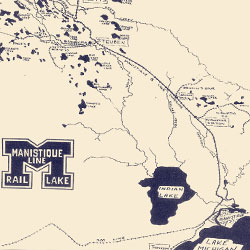
Location: mile marker 9 - Haywire Grade Trail
AN EVOLVING COMMUNITY
Also known as Hiawatha Junction, this was the site of a spur line that ran east toward the Hiawatha mill and post office. Other businesses included a lumber camp, hotel, sawmill and cattle companies. In 1900 the population was 185.
ABRAHAM BYERS AND THE HIAWATHA VILLAGE ASSOCIATION
Abraham Byers came to Hiawatha in 1885 to stake 10 homestead claims for himself and 9 relatives. Totaling 1,600 acres, the settlement prospered until the financial panic of 1893. In order to keep his land, Byers partnered with socialist Walter Thomas Mills in 1894 to establish a cooperative community.
Named the Hiawatha Village Association, the community supported 225 people on 1,060 acres of land. The experiment failed in 1895 when members left the commune due to poor business practices and disagreements over housing.
THE FOX FARM
In 1927 George Banzhaf and John Nieman began raising silver foxes on 80 acres near here. The farm supported up to 100 breeding pairs that survived on a diet of horse meat, grain and vegetables. The local geology played a role in the farm’s success. With the limestone bedrock close to the surface, the foxes were unable to tunnel under and out of their pens.
The farm, named the Rockville Company after the terrain, sold fox pelts at markets in New York and across the United States until 1949.
THE "OLD LADY"
In the 1920s station crew foreman George Smart was determined to stop a porcupine from gnawing on his front step. He struck the animal with a stove poker and left it for dead.
Mr. Smart’s children found the animal and nursed it back to health. Named “Old Lady,” the porcupine adapted well to captivity and gave birth to several large litters. Soon, tourists began to visit Hiawatha Station to see the porcupines.
- Haywire Grade Trail [Visit Manistique]
Beeson's Spur

Location: near mile marker 12 - Haywire Grade Trail
THE RAILROAD
In 1891 the Manistique & Northwest Railway Company (M&N) received a Michigan charter in order to increase lumber shipments to Manistique mills. After four years of planning, it took three years more to construct the train tracks from Manistique to Shingleton. The railroad went through two name changes before being purchased by the Manistique & Lake Superior Railroad Company (M&LS) in 1909. Along the way it acquired the nickname Haywire.
SHIPPING TRAIN CARS ON WATER
In 1897 the Ann Arbor Railroad began a ferry service between Manistique and ports on the lower peninsula. This made it possible for the company to transport train cars across Lake Michigan. By the 1920s automobiles used the ferry as well. The boat route to Ludington was the secondlongest on the Great Lakes at 138 miles and 11.5 hours. Ferry service to Manistique ceased operations in 1968.
ABIJAH WESTON
In the late 1800s New York native Abijah Weston founded the Chicago Lumber Company and several other businesses in the Manistique area. Weston was the primary supporter for construction of what became the Manistique & Lake Superior Railroad.
TIME LINE
- 1891 - The Manistique & Northwestern Railway Company is organized
- 1895 - Construction of railroad begins in Manistique
- 1897 - Railroad car ferry service begins at Manistique
- 1898 - Construction of railroad reaches Shingleton
- 1899 - Passenger service between Manistique and Shingleton begins
- 1902 - New ownership. Name changed to Manistique, Marquette & Northern Railroad
- 1908 - Railroad reorganized and renamed Manistique & Northern Railroad
- 1909 - Manistique & Lake Superior Railroad Company purchases the line
- 1968 - Manistique & Lake Superior Railroad Company and railroad car ferry service cease operation
- Haywire Grade Trail [Visit Manistique]
